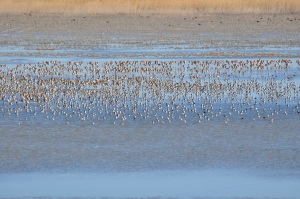For the love of brine flies, brine shrimp and phalaropes
Today’s post is by a guest blogger–my husband, Steve. He visited Antelope Island a couple of days ago and said the magic words to me: I want to write this week’s blog. Steve has been birding since age 6 and is the reason why I’m birding today.
Make Blue-green Brine Algae your dietary mainstay – 482 hundred gazillion Brine Flies can’t all be wrong. (Hey, it can’t be any worse than the jucified kale leaves that my wife, the Accidental Birder, makes me drink.)
The Great Salt Lake of Utah has a fascinating halophytic (salt-loving) ecosystem that makes it a renowned birding Mecca. Only a few species can thrive in its hypersaline conditions.

Blue-green algae–the basis of the Great Salt Lake ecosystem (click to enlarge)
Blue-green brine algae constitutes the basis of the very simple food chain that supports unfathomable numbers of brine flies and brine shrimp, which in turn, support shorebirds and waterfowl by the millions. The Great Salt Lake is a veritable protein-rich food factory.

Brine Flies congregate in huge mats feasting on the algae. (click to enlarge)
Starting in Spring and continuing all through Summer and well into the Fall, brine flies emerge from the shallow salty waters in astonishing numbers. The brine flies and the brine shrimp (Artemia franciscana) serve as an essential food source for millions of migratory birds.
It is the first week of Summer and therefore the first week of Fall migration. Already thousands of Wilson Phalaropes, American Avocets, Black-necked Stilts, and Willets are converging on the Great Salt Lake as a staging ground where they will double their body weight in preparation for their long migration to South America. Within a few weeks there will be tens of thousands of shorebirds and you can expect millions more on the Great Salt Lake by mid August.
The Wilson’s Phalaropes here are predominantly females that have finished breeding for the year. In a reversal of sexual roles the plainer males are still raising their young on the prairie sloughs of the Great Plains from Alberta and Saskatchewan down to Kansas and Oklahoma. By mid July the male phalaropes will be arriving at the Great Salt Lake in large numbers soon to be followed by this year’s fledgelings. It’s in August where you’ll find over a million Wilson’s Phalaropes (comprising between one third and one half of the world’s total population for the species) feasting on brine flies and brine shrimp of the Great Salt Lake.
So, within a few weeks from now other shorebird species, returning from breeding grounds on the arctic tundra, will soon join the local Avocets, Stilts, and Willets in the tens of thousands along with hundreds of thousands of Eared Grebes, which were just here back in early May as the Accidental Birder reported. Beholding such a sheer abundance of birds is truly spectacular and the Great Salt Lake should be on every birder’s bucket list.
Check out the gallery below for more photos of the convergence on the Great Salt Lake. (Click on any photo to enlarge and it will take you to a spectacular slide show.)
- Steve
- Hundreds of thousands of Eared Grebes as far as the eye can see.
- Two Willets feasting on brine flies.
- Thousands of Wilson’s Phalaropes and American Avocets are already fattening up.
- A pair of American Avocets and female Wilson’s Phalaropes
- California Gulls joining the feast (Utah State bird)
- Blue-green algae–the basis of the Great Salt Lake ecosystem
- Algae and brine flies
- Brine Flies congregate in huge mats feasting on the algae. (click to enlarge)
- A handful of brine fly chrysalis (pupal casings)
- Mats of brine fly chrysalis (pupal casings) stretch for miles along the shoreline
- Resting American Avocets
- Wilson’s Phalaropes feeding on brine shimp
- Antelope Island – one of Steve’s favorite birding spots
















Reblogged this on Sunnyace Collections.
LikeLike
Reblogged this on Sunnyace Collections.
LikeLike
Most excellent! The Great Salt Lake looks like such a wonderful place, and it’s gotta be if it gets its own birding festival!
The flocks there seem to be in epic proportions, and who knows how many other rare treasures are hidden in those big groups of Phalaropes and Grebes.
Great stuff, thanks for sharing.
LikeLike
Laurence, thanks for visiting! Can’t wait to get up there again and see all the shorebirds. (Though the flies can be a nuisance to humans. I always end up swallowing one or two. Ugh.)
LikeLike
Pingback: For the love of brine flies, brine shrimp and phalaropes « The Accidental Birder » My Great Salt Lake: Lake Elevated
Learned a lot! Great blog.
LikeLike